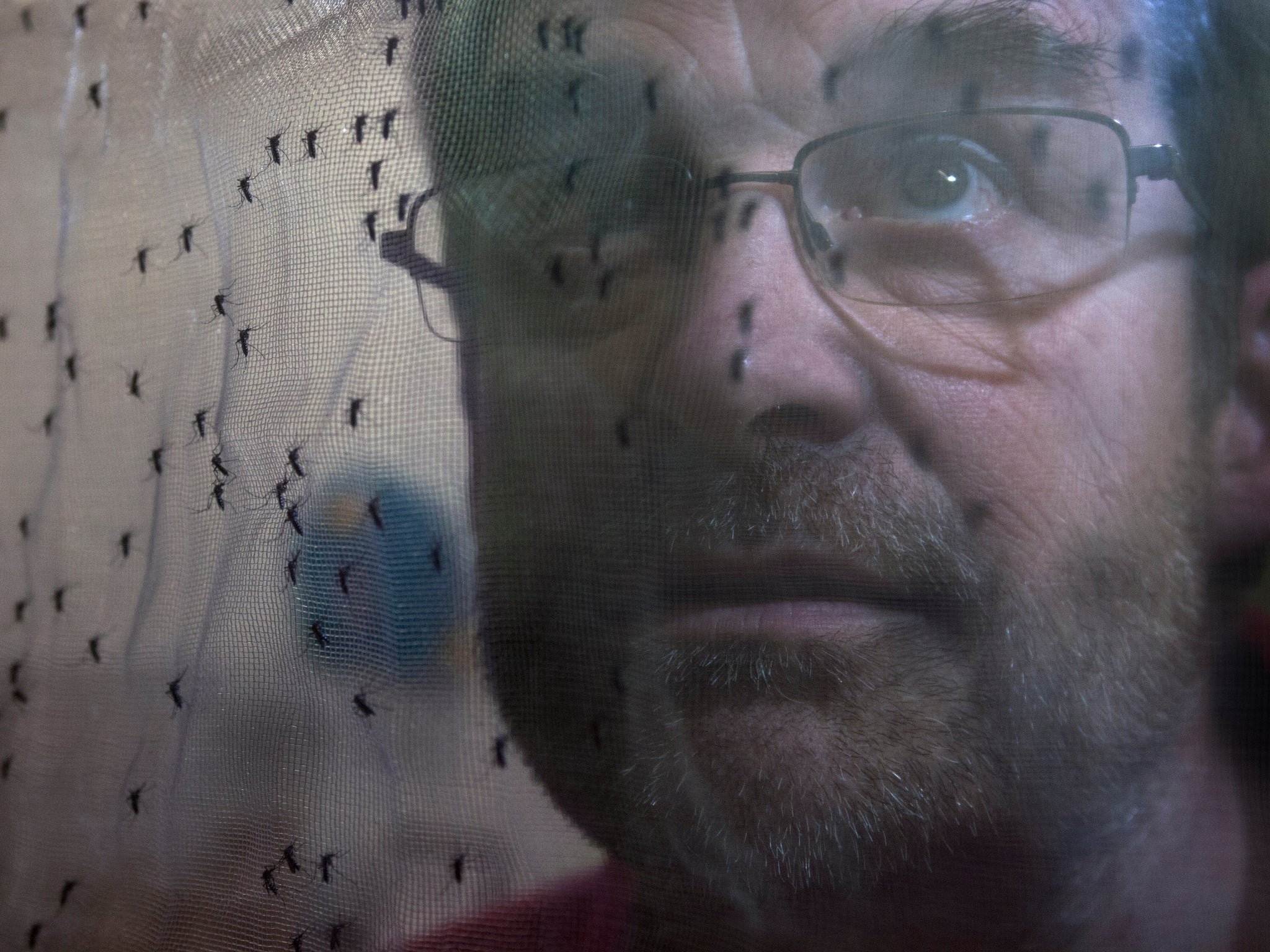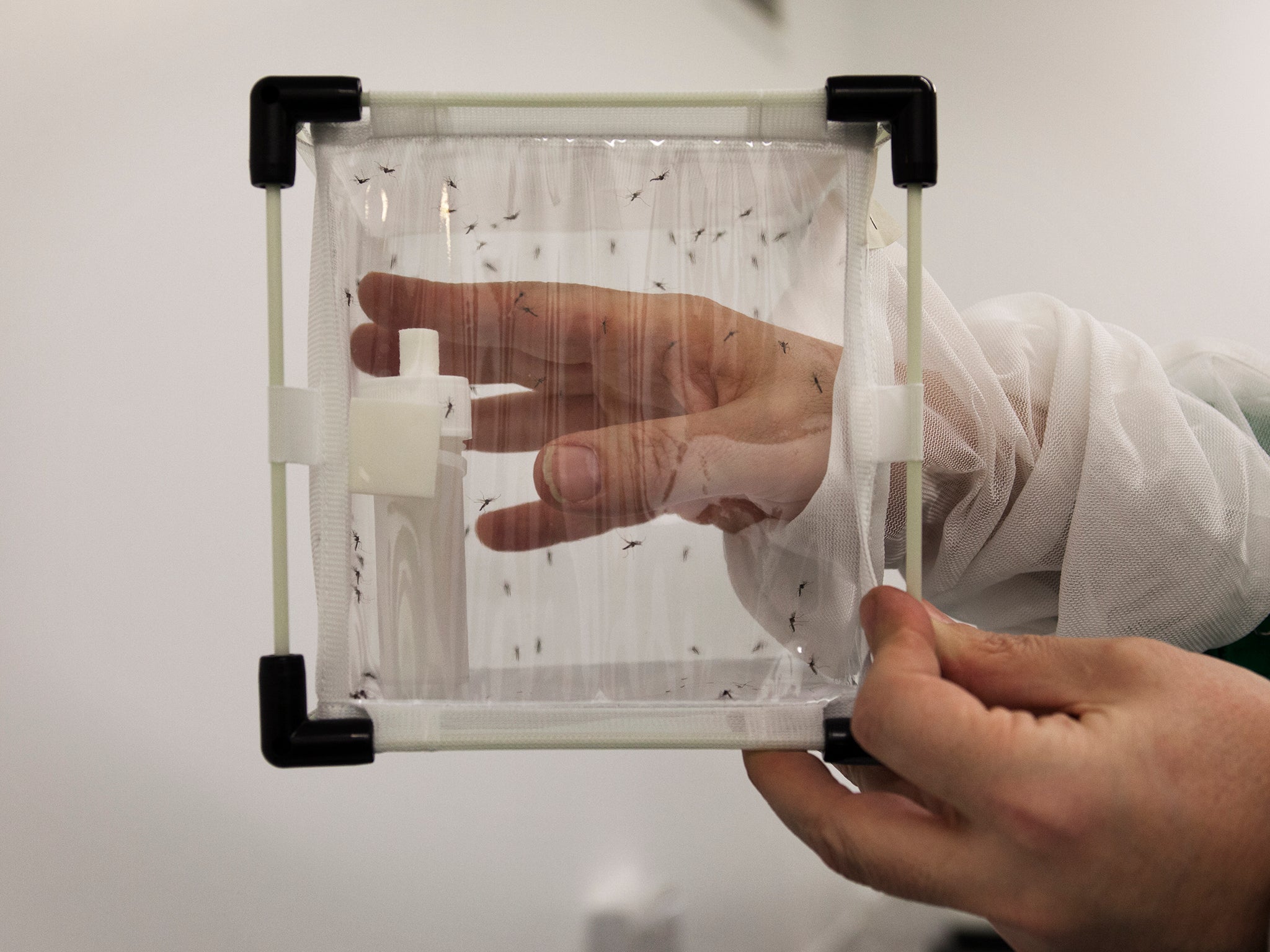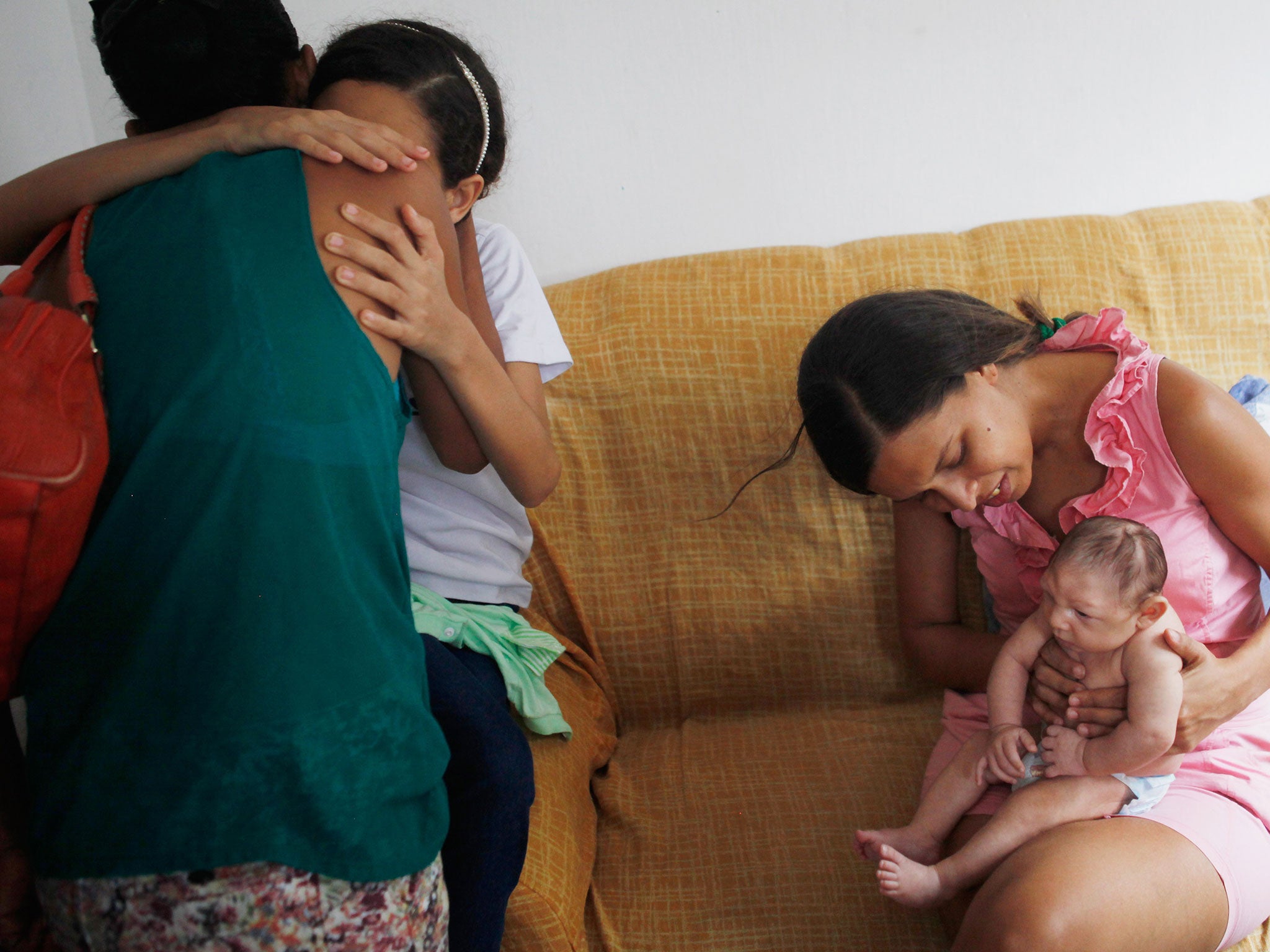Zika: Inside the British laboratory where scientists say they have a remedy for the virus
Genetics team believes it has the remedy: a modified strain of a mosquito that, by inter-breeding, will render the rest of them sterile

Apart from the white Renault’s slow pace, and the occasional puff of something out of its window, the Oxitec frontline vehicle looks just like any other of the vans that criss-cross Piracicaba each morning, before the town is quite awake. It follows the same route most days: crawling down the Rodovia do Açúcar, past the Unimep university and Delta Supermarket, until the sun is high in the sky, and all the cargo disposed of.
Then the driver – no longer carrying anything precious – hits the accelerator and turns back to a factory some 60km away. Curiously, the van doors never open. And a local not informed of what Oxitec does might be not only intrigued, but rather enraged, to see that – on closer inspection – those little puffs are formed of thousands of mosquitoes. Sitting in the back of the van, an Oxitec employee shakes pots of 1,000 mosquitoes each out into the street – via the medium of a cone and a bladeless fan – at release points signalled to him on an iPad. It is the creatures’ first breath of fresh air.
They hover for a moment, in something of a daze, before dispersing hither and thither to search for the particular sound of female wingbeats. So goes the release of the only genetically modified insects in existence: Aedes aegypti by appearance; OX513A, as they are titled in the Oxitec catalogue.
Aedes aegypti, in its natural form, is the “vector” for Zika, a virus that – like the insect itself – originated in Africa. The simplest way to stop Zika spreading is to remove its vector, and with the World Health Organisation’s (WHO) announcement earlier this week that Zika constitutes a public health emergency, suggestions for how to kill aegypti, quickly and in large numbers, have assumed vital importance. As with Ebola, the last public health emergency, old-fashioned methods top the pile. During the Ebola crisis, in Liberia, Guinea and Sierra Leone, people were warned not to shake hands or hug, and to burn the bodies of the dead. In Brazil, soldiers are going door to door, explaining that aegypti can breed in even the smallest of pools, such as the dregs in a can of Coke; women have been advised not to get pregnant; and fogging machines drive up and down city streets, pumping out insecticide.

It was in not altogether dissimilar fashion that the American epidemiologist Fred L. Soper chased a malaria-carrying mosquito out of Brazil in the 1930s (and other species in the decades that followed). Soper, though, was a rare kind of zealot, the sort of man who would have a mountain moved if it exposed a family of Anopheles Gambiae. He lost 27 pounds in three months on the job, as he climbed gutters and personally inspected homes. Also aiding the purge was the Brazilian brand of politics: the country was then under the control of Getúlio Vargas and his military junta; personal liberties came a distant second to the war on the mosquito. It is impossible, Soper was known to say, to eradicate mosquitoes in a democracy.
That sums up the task President Dilma Rousseff and her Partido dos Trabalhadores, or Worker’s Party, face. Modern cities have grown larger and messier than they were in Soper’s day. And if an inhabitant of the Vasco de Gama neighbourhood in Zika-hit Recife would rather keep her dozen songbirds and the water bowls from which they drink (and in which aegypti will breed), there is not a great deal the government can do.
Perhaps the owner of the birds is no longer able to have children, so does not fear a bout of Zika, which leaves most adults completely unharmed. The risk then transfers to her neighbours. Aegytpi can fly around 200 yards. In November, an obstetrician in north-eastern Brazil, Adrianna Melo, confirmed that a surge in the number of children born with mis-shapen heads – a condition known as microcephaly – was linked to the Zika virus that had previously gone unnoticed in their mothers. The brains of these children do not develop properly, and they face severe learning difficulties, and the possibility of an early death. Some 2,100 Colombian pregnant women have been confirmed as having the Zika virus; thousands more do in Brazil, and across 20 other countries in the Americas. The Caribbean is another hot-spot, and cases of Zika have started to show up in the southern United States (and allegedly in Europe, through sexual transmission). In many Latin American nations, it is near-impossible to procure a legal abortion, so infected mothers to-be face months of wrenching panic.
“We could do it,” Hadyn Parry, the CEO of Oxitec, told me, as we stood among the Velcro and gauze mosquito “cages” in the company’s Abingdon headquarters. “If someone said that [ridding Brazil of Aedes Aegypti] is the plan, you would get on with it… but someone has to say, ‘I’m up for it, I’ll pay for it. What help do you need?’”

Parry is unruffled by the overnight transformation of his small company, which employs 100 people between Abingdon and Brazil, into a great white hope for Zika control. Dressed in a red protective coat over a blue-and-white striped shirt, he possesses a kindly, frank manner, talking more like a retired soldier than a biotech impresario (until 2013, he was also chair of the Help for Heroes charity, and comes from a military family, “half army, half navy”). The advantage of Oxitech’s technology, he says, is that it removes the need for people to chase down straggling aegypti, which may lurk unobserved under a plant pot outside the window, untouched by any fumigation indoors. A single breeding female can lead to chaos. If one remains in one water bowl in Vasco de Gama, it could over its month-long lifespan produce 500 more mosquitoes, which – uncontrolled – could give birth to a further 125,000 before they themselves die off, producing millions more.
“On the other hand,” Parry explained, as a press officer standing to one side attempted to pincer a mosquito that had somehow extricated itself from the cages, “if you release 100 of our males, those males are going to go anywhere, and go and find the girls, because that’s what males are very good at”.
Oxitec produces male mosquitoes with one key difference: they have been genetically engineered so that their children do not survive into adulthood. In the 20 or so cages in the Abingdon laboratory, thousands of OX513A brand aegypti were hovering about, or resting on a black rag hung from each cage’s ceiling. These were the breeders. Their eggs, which resemble a fine black dust, can be collected in Tupperware boxes and dispatched to anywhere in the world, before they are submerged in chemically treated water, and then turn into larvae. A simple sieve removes the females, too big to fit through the holes, leaving only the precious, feebler males behind.

Yesterday morning, as on every weekday, Guilherme Travellato and his two-man team released another 160,000 or so Oxitec males onto the streets of Piracicaba. Over the course of each week they free around 800,000. Compelled by evolution to find a mate, and by man to produce no heirs, these creatures carry out their dual role with abandon. Part of Travellato’s job is to monitor local populations. “It’s not the only tool, but it’s a really efficient one,” he said, talking over the phone from Campinas, in São Paulo state, where Oxitec’s main factory is based.
Small-scale tests in Panama, the Cayman Islands and throughout Brazil consistently show a reduction of 90 per cent and above in the number of aegypti – a remarkable rate. Locals gather to celebrate the van’s passage – though lately, the owner of a mini-mart in Piracicaba, Supermarket Valor, has complained that Oxitec has hurt his sales of Gatorade. (Those who contract dengue fever experience parching thirst – but with so many fewer falling sick, the demand for the Blue Raspberry’s rehydrating power has fallen away.)
It took months for the international community to rouse itself against Ebola, months that allowed the disease to spread and eventually kill around 11,000 people. Lessons appear to have been learned. The emphasis with Zika lies on being prepared to do too much, rather than risk doing too little. And yet, in some ways, the world had a head start with Ebola. Although very little attention was paid to controlling its symptoms, since the disease affects primarily poor people in poor parts of Africa, researchers in the West had nonetheless focused on it as a potential weapon in bio-warfare, and witnessed a number of smaller outbreaks since 1976. Vaccines were produced relatively quickly. In comparison, very few epidemiologists had heard of Zika six months ago. A vaccine is at least a decade away. We learnt only last week that Zika can be transferred sexually, and still have no idea whether it is the virus that causes babies to be born with smooth, unfinished brains or some other factor connected to it.

Oxitec, at this very moment, is not in the position to be of great help. The company has yet to grow out of its own pupa. Live trials were first conducted in 2009, but its Campinas factory can only provide GM mosquitoes for an area that is home to 10,000 people. Though the technology’s potential has been highlighted in editorials for the New York Times and the Economist, there is an element of hype to the coverage. Oxitec has so far operated in dengue-hit zones, not on to the frontlines of the Zika crisis, though the two are often contiguous, and what works for one will work for the other.
Still, another factory – capable of serving 300,000 people – is now under frantic construction. Zika has “thrown all our plans into question”, said Parry, as we walked from the lab to another warehouse containing R&D facilities. “Should we build one new factory or 10?” From scratch, it took three months to get this warehouse into an operational state. If the Brazilian government were to step in and centrally adopt Oxitec technology, rather than leaving it to local municipalities to decide, Parry estimates the country could be abuzz with OX513A aegypti within a year.
Even those open to GM may find a twang of alarm hard to suppress. Conspiracies – growing in puddles of ignorance, whirring like mosquito wings – have flourished over the past week. One poster on a Reddit forum dedicated to conspiracy theories argued that Oxitec’s mosquitoes may be responsible for Zika itself, a supposition that has since been lent credence for its being republished on the websites of unscrupulous national newspapers (but loses any when you consider that the company was founded more than 50 years after Zika was first discovered).
In fact, the WHO and the Brazilian government agree that Oxitec’s technology poses no risk to people or the environment. And there is remarkable consensus across the scientific community that Oxitec is safe. “These people have spent months and years evaluating it,” Parry explained, leading the way to a changing room, where green safety smocks were to be put on, and plastic bags wrapped over our shoes. “It’s a shame that a solution that could save a lot of lives is being questioned by some idiots.”

At the end of a sparse, windowless corridor, we entered a research lab. In one corner a young scientist was intently probing at mosquito eggs with a minuscule needle. Four pupae lie under a high-powered microscope, looking like nothing so much as tiny, gelatinous Cornish pasties, one indistinguishable from the next. I am asked to guess which were Oxitec products. Then a light went on, a red filter was put over the lens, and the top two started to glow a startlingly iridescent red.
Research scientist Sian Spinner explained this is due to the second gene that Oxitec introduces into the DNA of aegypti – one transplanted from jellyfish, serving to permanently mark out the engineered creatures. Unless it glows red like this, Oxitec had nothing to do with a mosquito. Thus, monitoring teams can gather eggs and test them to see what proportion light up; since these will not make it to adulthood, the company can measure its success.
Still, not every citizen of Piracicaba can be shown the inside of an Oxitec laboratory, so the company ran outreach programmes for months before it started releasing mosquitoes. The key message to get across was that Oxitec’s mosquitoes are “friendly”. Employees refer to them as “our sons”, and to their stillborn children, as “our grandsons”.
What seems to do the trick best, Travellato noted, is the cage of Oxitec mosquitoes that emloyees carry around, into which locals can put their hands and see that they are not bitten. This may not explain how the mosquitoes kill off future generations of aegypti, but at least it shows that the GM creations will drain no human blood. I put my hand inside a replica in Abingdon. The modified aegypti went into a flutter, attracted by the pheromones and warmth, which promised the arrival of females. One settled on my thumb. I could feel tiny currents of air from its wings – but that was the most of it.
When one is not under direct threat of contracting Zika or dengue, there is more time to ponder what effect eradicating large proportions of Aedes Aegypti will have on local ecosystems. Some argue that the mosquitoes should be left in place, and efforts diverted to speeding up the search for a vaccine. But even a total wipe-out of Aegypti would, Travellato said, leave little trace on the environment. It is an invasive species, and – in cities – mainly breeds indoors, so no predator relies on it as a sole source of food. “You don’t see fish on your roof,” Travellato told me, “you don’t find dragon flies in your water tank.”
If there is to be a stumbling block, it will involve money. Oxitec is a business, with shareholders. Trials so far have been run to establish that the product works; in future, local municipalities, or national governments, will have to purchase eggs from Oxitec, or pay for the establishment and running costs of their factory, where OX513A can be bred. Prices have not yet been declared, as Oxitec’s new license is pending. But the question for politicians across Latin America and the Caribbean now is: how much are you willing to pay? If the virus continues to spread, or merely takes root, as experts suggest it will, the cost in lost tourism will be large. The cost for parents is frankly unimaginable.
Join our commenting forum
Join thought-provoking conversations, follow other Independent readers and see their replies
Comments